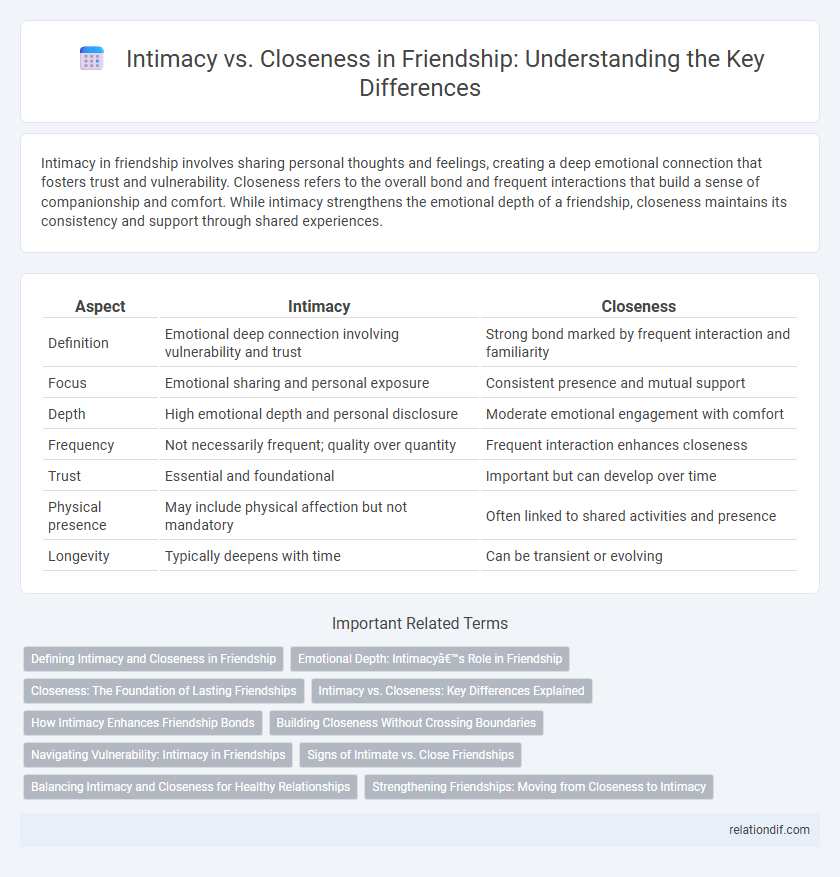Intimacy in friendship involves sharing personal thoughts and feelings, creating a deep emotional connection that fosters trust and vulnerability. Closeness refers to the overall bond and frequent interactions that build a sense of companionship and comfort. While intimacy strengthens the emotional depth of a friendship, closeness maintains its consistency and support through shared experiences.
Table of Comparison
| Aspect | Intimacy | Closeness |
|---|---|---|
| Definition | Emotional deep connection involving vulnerability and trust | Strong bond marked by frequent interaction and familiarity |
| Focus | Emotional sharing and personal exposure | Consistent presence and mutual support |
| Depth | High emotional depth and personal disclosure | Moderate emotional engagement with comfort |
| Frequency | Not necessarily frequent; quality over quantity | Frequent interaction enhances closeness |
| Trust | Essential and foundational | Important but can develop over time |
| Physical presence | May include physical affection but not mandatory | Often linked to shared activities and presence |
| Longevity | Typically deepens with time | Can be transient or evolving |
Defining Intimacy and Closeness in Friendship
Intimacy in friendship refers to the deep emotional bond that involves sharing personal thoughts, feelings, and experiences with trust and vulnerability. Closeness emphasizes the degree of connection and frequency of interaction, reflecting how often friends engage and support each other. Both intimacy and closeness contribute to the strength of a friendship but differ in the depth of emotional sharing versus social engagement.
Emotional Depth: Intimacy’s Role in Friendship
Emotional depth in friendship is defined by intimacy, which fosters vulnerability and genuine understanding between friends. Intimacy allows individuals to share fears, hopes, and personal experiences, creating a unique bond that transcends mere closeness. This profound emotional connection strengthens trust and solidifies long-lasting, meaningful relationships.
Closeness: The Foundation of Lasting Friendships
Closeness in friendship involves consistent emotional support, mutual trust, and shared experiences that create a strong bond over time. This foundational element fosters a sense of security and understanding, enabling friends to navigate challenges together. Unlike fleeting intimacy, closeness sustains enduring relationships by cultivating loyalty and deep connection.
Intimacy vs. Closeness: Key Differences Explained
Intimacy in friendship involves a deep emotional connection characterized by trust, vulnerability, and sharing of personal thoughts and feelings. Closeness, on the other hand, refers to the physical or social proximity and frequency of interaction between friends, which may not always include emotional depth. Understanding the distinction between intimacy and closeness is crucial for nurturing meaningful relationships that balance emotional bonding with time spent together.
How Intimacy Enhances Friendship Bonds
Intimacy enhances friendship bonds by fostering deep emotional connections and trust, allowing friends to share vulnerabilities and personal experiences openly. This emotional closeness strengthens mutual understanding and support, creating a resilient relationship foundation. The development of intimacy in friendships often leads to increased empathy, loyalty, and long-lasting companionship.
Building Closeness Without Crossing Boundaries
Building closeness in friendship requires balancing emotional intimacy with respect for personal boundaries to create trust and comfort. Sharing experiences and thoughts gradually deepens connections while maintaining individual space prevents discomfort or dependency. Establishing clear communication about limits fosters mutual understanding and supports a healthy, enduring bond.
Navigating Vulnerability: Intimacy in Friendships
Navigating vulnerability in friendships requires balancing intimacy and closeness, where intimacy involves sharing personal thoughts and feelings while closeness reflects emotional support and trust. True intimacy fosters deeper connections by encouraging openness and authenticity, essential for sustaining meaningful friendships. Maintaining boundaries ensures that this vulnerability leads to mutual respect and strengthened bonds rather than discomfort or overexposure.
Signs of Intimate vs. Close Friendships
Intimate friendships are characterized by deep emotional sharing, vulnerability, and trust, often marked by confiding personal secrets and offering unwavering support during crises. Close friendships, while still supportive and caring, tend to focus more on shared activities, mutual interests, and consistent companionship without necessarily involving profound emotional disclosure. Signs of intimate friendships include empathetic listening and emotional validation, whereas close friendships are indicated by frequent communication and enjoyment of each other's company in everyday settings.
Balancing Intimacy and Closeness for Healthy Relationships
Balancing intimacy and closeness is essential for healthy friendships, as intimacy fosters emotional connection while closeness ensures mutual respect and personal boundaries. Healthy relationships thrive when friends navigate vulnerability without overwhelming dependence, maintaining trust and open communication. Recognizing the difference between intimacy and closeness supports sustainable, fulfilling friendships grounded in understanding and autonomy.
Strengthening Friendships: Moving from Closeness to Intimacy
Strengthening friendships involves deepening connections beyond mere closeness by fostering emotional vulnerability, trust, and authentic sharing. Intimacy in friendship is characterized by meaningful conversations and mutual understanding, which solidify bonds and promote lasting support. Prioritizing quality time and empathetic listening transforms casual connections into profound, enduring relationships.
intimacy vs closeness Infographic

 relationdif.com
relationdif.com